#🜎 Cosmos can Draw Sometimes | ARTWORK
Explore tagged Tumblr posts
Text




cosmos edits// my youth is yours.
23 notes
·
View notes
Text
Okay favorite OC ship time-

#original character#oc#art#spaceages#oc artwork#Sometimes i just remember i can draw them for fun#Its an odd thing to forget your ocs are yours#but its always a fun thing to remember#stephenson ken royden#oc brainrot#Spacey Cosmos#spacey and stephenson hold a very special place in my heart
2 notes
·
View notes
Text
Ancient Rock Art May Depict Shamanic Music
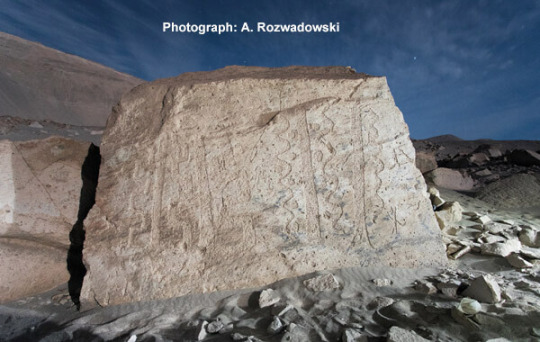
More than 2,000 years ago, the Tukano people of the Colombian Amazon may have documented the soundtracks to their hallucinogenic experiences in petroglyphs on volcanic boulders. Consisting of what appears to be dancing human figures surrounded by zigzagging lines and other geometric forms, the enigmatic art eludes concrete interpretation, although a new analysis suggests that these abstract shapes may depict the songs that transported participants to other dimensions during Ayahuasca ceremonies. The pre-Columbian designs can be found at Toro Muerto, which contains one of the richest collections of rock art in South America. A desert gorge, the site is strewn with thousands of boulders, some 2,600 of which feature ancient carvings.
Describing the drawings in a new study published in the Cambridge Archaeological Journal, researchers explain that the artworks contain "an almost overwhelming repetition of images of dancing human figures (known as danzantes), unique in the region, and an extraordinary accumulation of geometric patterns, most often in the form of vertical zigzag, straight and sinuous lines varying in width, sometimes with accompanying dots or circles." Previous attempts to interpret these zigzags have suggested that they may represent snakes, lightning, or water, although the study authors believe they may have an alternative meaning.
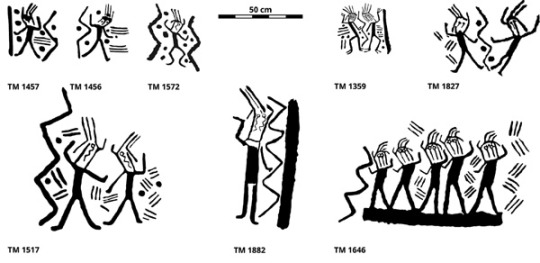
Examples of "danzantes" at Toro Muerto. Image credit: Tracings: Polish-Peruvian research team, compiled by J.Z. Wołoszyn/Cambridge Archaeological Journal/2024 (CC BY 4.0)
To build their hypothesis, the researchers point out the striking similarities between the drawings at Toro Muerto and the traditional artwork of the Tukano culture in the Colombian Amazon. In the case of the latter, geometric designs have been linked to the visions induced by the hallucinogenic brew Ayahuasca, which has been ritually ingested by Indigenous Amazonian communities for millennia. According to the Tukano these drawings were 'yajé images', meaning that they showed patterns they had seen while in an altered state of consciousness induced by consuming entheogens. Concentric circles, dots, wavy lines, zigzags and crenellation motifs dominated among them.
Anthropological analyses of these rituals have repeatedly highlighted the importance of music, with songs known as icaros being sung by shamans as a means of communicating with the gods and journeying through the spiritual cosmos. Ritual in many human cultures involves music; it is a key social technology for building and sustaining community. Ritual music is a universal way to address the spirit world and provide some kind of fundamental change in an individual's consciousness or in the ambience of a gathering. Experiences of ego loss and trance are important for integrating the individual into the group and maintaining community, and music is a significant element of such ritual activity.
Intriguingly, studies into the significance of zigzags in Tukano artwork have revealed that "the Tukano saw in them the representations of songs which were an integral part of the ritual, having also agentive power, and constituting a medium for transfer to the mythical time of the beginning." In other words, within a Tukano context, these shapes depict the shamanic music that mesmerizes ritual participants under the effects of Ayahuasca, delivering them to an alternate reality in which they are able to reconnect to their ancestral mythology.
Admitting that their theory is somewhat speculative, the researchers nonetheless conclude that these pre-Hispanic drawings "illustrated a graphically elusive sphere of culture: singing and songs. The interpretation we propose is of course hypothetical, but the conclusions it leads to constitute a logically coherent counter-proposal to previous interpretations of some of the Toro Muerto petroglyphs. We suggest that zigzag lines could be representations of songs, which seems particularly intriguing given the repeated juxtaposition of these patterns with the figures of dancers at Toro Muerto, not only in the more complex compositions but also in the less complex as well."
#archaeology#petroglyphs#shamanic practice#shamanism#shamanic journey#shamans#ayahuasca#ayahuasca art#amazon basin#anthropology
11 notes
·
View notes
Text
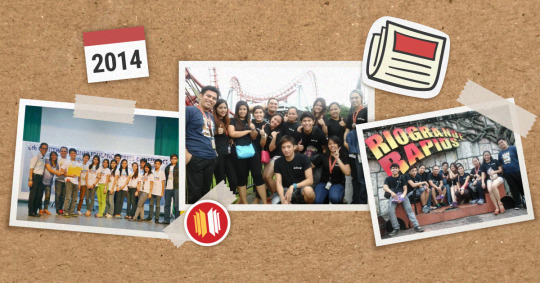
That's it!
The people whom I based the stories I posted these past few weeks are in the images above. Seven of them are not there though and two people who are present are actually not included—I’m not pertaining the two professors on the far left who were from different schools. Pondering upon these thoughts now made me wish that I did make stories about the other two as well—maybe the 21 year old me couldn’t find a way to squeeze them in.
If you have no I idea what I'm talking about since you've only just seen this post, please read the series Souls of the Gateway Kingdom—a.k.a. The Game of 13 Characters—here in my blog. I recommend that you scroll down and start reading with the post “A foreword” then read the characters’ stories in order and finish with “At the end…”.
If you’re one of the very few people who read original version, you have may have noticed a lot of differences—aside from the full color illustrations, of course. I thought it would be better to add more dimension to the characters that lacked depth and removed some parts that would probably be harmful for some people. Some of the new stuff were also based on real events back then. To give more impact to these additions, I had to change the order of posting as well. I also added a new character that would serve as a concluding note—that was the only illustration that I drew from scratch this year, everything else were the exact original line arts.
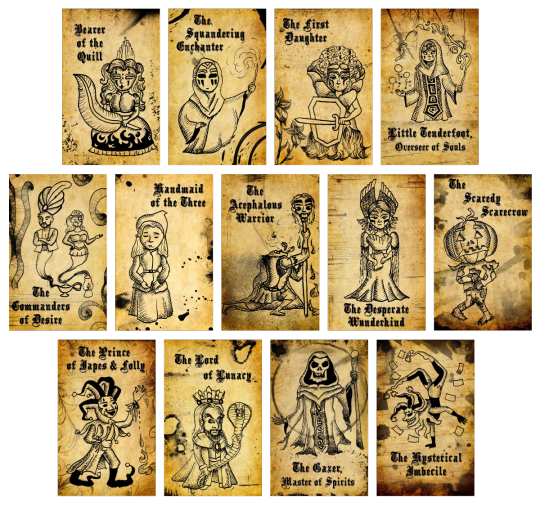
Original artworks made for the game.
Reg won that game nine years ago (almost exactly since the winner was announced on May 25). And then a few months later, she succeeded me as the Editor-in-Chief of the school paper—just as I wanted. And it’s funny that during the editorial board screening, when I was on the judging panel and we were asking the would-be members who they think deserved to be my successor, they were all saying her name and they had good reasons for it. And in the back of my mind, all I could think of was maybe their thoughts were influenced by my freakin’ game.
Going back the images above… Those were the people that made my college life more memorable, more enjoyable, and definitely more dramatic—you can tell by the stories I’ve created. I miss it sometimes—I’m not only referring to the people but also the work and the friendship we had.
Perhaps these are just a thing in my past—that surely made a huge influence to the person I am now—but if the opportunity rises for me to somehow come back, I might welcome it with open arms. Who knows?
P. S. My friend Annie saw the God of Chaos character illustration and thought it was really good—a beautiful chaos, she said—and that my improvement as an artist is very evident in that drawing. So, she urged me to make another series, like a sequel or something that would have a similar art style. And… I’m actually planning on doing another series like this, or something like the Letters to the Cosmos, and I still haven’t scrapped that idea yet. I can’t tell much right now.
4 notes
·
View notes
Text

I just completed another digital art piece—a fan art of Chloe Carmichael from "The Fairly OddParents." The thrill of bringing her character to life in my style filled me with an odd mix of joy and pride. If there’s one thing I love about creating fan art, it’s the chance to express my interpretation of a beloved character while staying true to their core traits and essence. Chloe Carmichael, a new addition to the main cast in Season 10, is Timmy Turner’s neighbour and one of his few genuine friends. She’s a whirlwind of energy, ambition, and optimism, and I felt excited and challenged to capture her bubbly personality in this artwork.
In my piece, Chloe stands amidst a vibrant, blossoming meadow, arms spread wide as if she’s about to pull the entire world into a big, enthusiastic hug. Her blue eyes, big and bright, radiate that characteristic spark of hers—a mix of enthusiasm and determination that, once noticed, is impossible to ignore. Her hair, a cascade of golden blonde, flows down her back, capturing a bit of sunshine in every strand. I added a purple bow to her hair, which perfectly complements her cheerful demeanour and makes her seem playful and stylish.
Chloe’s outfit in this artwork mirrors her zest for life. She’s dressed in a yellow sleeveless top with white trim at the hem, a colour that practically screams “sunshine.” Paired with black leggings and purple sandals, her look is simple yet effective, capturing her childlike spirit while giving her an air of practicality. I’ve always admired characters who can look both adorable and functional. This balance makes Chloe relatable like she could be any of the kids you see running around the playground. But her outfit wouldn’t be complete without her signature purple bow and, of course, that little gap in her teeth that peeks out when she smiles. It's such a small detail, but somehow it makes her character feel even more genuine.
Chloe is such a fascinating character to draw, not just because of her outward appearance but because of everything she stands for. Born on the same day as Timmy, she’s his unlikely counterpart in so many ways. While Timmy often wishes for things purely for himself, Chloe’s wishes are, more often than not, to help others. I remember watching an episode where she wished for resources to protect endangered animals and another where she wished to reduce pollution. Her good intentions sometimes get her into trouble, but her heart is always in the right place. I admire her dedication to making the world a better place, and in my artwork, I tried to capture that spark of idealism and hopefulness in her eyes and the openness of her posture.
Chloe’s character is full of quirks that make her both endearing and relatable. She’s an over-achiever with a boundless “can-do” attitude and an unwavering optimism. Even though life doesn’t always reward her good intentions, Chloe pushes forward, determined to help others, no matter the cost to herself. This drive to do good can sometimes lead her into chaotic situations, but she keeps going, unfazed by the challenges. In many ways, she embodies that childlike spirit of resilience, where even if the world knocks you down, you get up, dust yourself off, and try again. Capturing this aspect of her personality was important to me, so I posed her with open arms, almost as if she was inviting the viewer to share in her enthusiasm.
Her high-energy nature is both a strength and a weakness. While her determination and optimism are commendable, they can also be overwhelming, both for her and the people around her. Timmy, for example, initially found her overbearing. He was used to having Cosmo and Wanda, his Fairy Godparents, all to himself, and Chloe’s presence felt like an intrusion. Not only did she suddenly share his Fairy Godparents due to a shortage in the fairy world, but her constant drive to do good also made Timmy look like a slacker in comparison. I remember watching an episode where he grew frustrated with her relentless optimism, feeling as though he was forever being outshined. Yet, despite their differences, Chloe and Timmy eventually found common ground. Their friendship developed slowly, built on mutual understanding and acceptance, and eventually, they became each other’s only real friend.
To me, this relationship between Chloe and Timmy is one of the most compelling aspects of her character. Chloe may be an over-achiever, but that same drive isolates her from her peers. Her high standards and refusal to compromise sometimes make it hard for other kids to relate to her, leaving her lonely despite her many accomplishments. In one episode, Timmy learns that her goody-two-shoes personality leaves her without friends, and that’s when he softens towards her. It’s a touching moment because it shows that underneath all her enthusiasm, Chloe is still just a kid wanting acceptance and friendship. I wanted my artwork to reflect this, so I gave her a joyful expression as if she’s finally found a friend who accepts her quirks and all.
Another side of Chloe that I find intriguing is her vulnerability. Despite her energetic, go-getter attitude, she’s prone to extreme emotions and, at times, bouts of mania. Her determination can swing to obsession, as seen on her birthday each year when she becomes hyper-focused on being the centre of attention. Normally, Chloe is all about helping others and spreading positivity, but on this one day, she lets her desires come first. I can’t help but find this relatable; everyone has that one day where they want to feel special and acknowledged. In my artwork, I hinted at this trait through her wide, almost manic grin, a subtle reminder of how even the kindest hearts can crave a moment of personal glory.
Chloe’s high energy and strong moral compass often lead her to clash with Timmy. They argue, they compete, and sometimes, they hurt each other’s feelings. One episode that stands out to me is “Birthday Battle,” where they both throw competing birthday parties, each trying to outdo the other. It’s such a classic kid thing to do, this needs to be “the best,” and it reminds me of the friendships I had growing up. I wanted this artwork to capture that competitive yet affectionate bond they share. Even though she and Timmy argue, there’s a deep respect and understanding between them. Chloe cares for Timmy deeply, and Timmy, in turn, has come to appreciate her loyalty and kindness, despite how irritating her perfectionism can be at times.
One of Chloe’s biggest challenges is her struggle to say no. She’s such a people-pleaser that even when something doesn’t benefit her, she’ll go along with it just to keep others happy. There’s a scene in “Whittle Me This” where she can’t bring herself to tell Catman, an eccentric hero, that she’s not his former sidekick. Her unwillingness to disappoint him almost ends in disaster, with her Fairy Godparents nearly getting captured by Mr. Crocker. This moment, like so many others, illustrates how her kind-heartedness can sometimes lead her into tricky situations. It’s a double-edged sword, this relentless positivity and desire to help, and it’s what makes her character so interesting. In my fan art, I wanted to hint at this characteristic by giving her an open and inviting posture, as if she’s saying, “I’m here to help, no matter what!”
Chloe’s favourite show, "The Fair Bears," is a perfect fit for her personality. The show’s message about being fair and kind to others resonates deeply with her values. Watching her enthusiasm for The Fair Bears in the show always makes me smile because it’s such a genuine reflection of her character. Chloe doesn’t just talk about kindness; she lives it, sometimes to her detriment. Her compassion is so strong that she even embraces Timmy’s quirks and flaws, accepting him as her friend despite his many mistakes and selfish tendencies. For this reason, I wanted the background of my artwork to be a vibrant, blooming garden, symbolising Chloe’s love for all living things and her nurturing spirit.
In the end, Chloe is a character of contrasts. She’s bubbly yet vulnerable, strong-willed yet overly accommodating, and kind-hearted yet prone to obsession. In my fan art, I hoped to capture all these facets of her personality—the joy, the optimism, the intensity, and the hint of loneliness that lies beneath her cheerful exterior. Fan art isn’t just about recreating a character’s appearance; it’s about distilling their essence into a single moment, a single expression, a single gesture. And for Chloe, that moment is one of pure, unabashed enthusiasm, as she stands with arms wide open, ready to take on the world, one good deed at a time.
#chloecarmichael#chloecarmichaelfanart#chloecarmichaelxtimmyturner#chloethefairlyoddparents#thefairlyoddparentschloe#thefairlyoddparents#thefairlyoddparentsfanart#thefairlyoddparentsart#digitalart#digitalartist#digitalartwork#digitalartists#digitalarts#digitalartworks#digitalartistry#digitalartistoninstagram#digitalartgallery#digitalartpainting#girlportrait#girlportraits#girlportraitdrawing#girlportraiture#girlportraitart#girlportraitpainting#girlportraits_shot#girlportraits_ig#girlportraitillustration#girlportraitsstyle
0 notes
Text
Alive in the Human Hive. 🌍
We measure mountain with feet and emotions with colours. We are funky little space monkeys orbiting a ball of boiling hot gas. We jibber-jabber to ourselves and each other on some kind of cosmic spectrum. Seven and half billion humans, a proud crowd, a team of teeming sapiens, a swarm of warm blooded beings. Planet Earth is a garden and we are the insects. The artworks I make are an absurd visual taxonomy, listing in no particular order the ingredients we all consume and produce. Everyday we fill ourselves up and empty ourselves out, physically and emotionally, from the highest heads of state to the lowest lives, the displaced or imprisoned, we all suffer and celebrate, appetites and desires, fears and misfortunes. How can I paint a picture of the world? The local and the global landscape. Planet Earth is place so strange so full of beauty and wonder, mistakes and confusion. This confusion is very important to me, it feeds me and my work. I am weaving a web of images and ideas that overlap collide and conjure something of the flux and energy that keep us all moving forward. Planet Earth is spinning through space at 1000 miles per hour, paintings and drawings help me slow down and fix something in place. I am attempting to join the dots and draw a constellation, mapping my place in the universe. I am a blip, in a vast ever expanding cosmos. It is overwhelming sometimes, I am looking to lose myself and find myself in a visual vocabulary and grammar that sings a universal song : Relax, you are alive in the Human Hive.
Film and edit by @nickjsthompson A film to coincide with my installation at @morganfurniture in 2019. #davidshillinglaw #aliveinthehumanhive
0 notes
Text

screams why is his face so hard
#🜺 Cosmos can Draw Sometimes | ARTWORK#its so rough ; - ; i think im fine with his pose for now but :y
20 notes
·
View notes
Text
more tags
❝ ― Highly Recommended | PROMO
❝ ― Would you kindly? | SELFPROMO
❝ ― Cosmos can Draw Sometimes | ARTWORK
❝ ― Precious Gifts | KEEPING IT FOREVER
❝ ― Downtime | INBOX MEMES
❝ ― Patiently Waiting | QUEUED PROGRESS
❝ ― CosCos rambles | OOC
#❝ ― Highly Recommended | PROMO#❝ ― Would you kindly? | SELFPROMO#❝ ― Cosmos can Draw Sometimes | ARTWORK#❝ ― Precious Gifts | KEEPING IT FOREVER#❝ ― Downtime | INBOX MEMES#❝ ― Patiently Waiting | QUEUED PROGRESS#❝ ― CosCos rambles | OOC
0 notes
Photo



ITADORI YUJI IN PINK
#🜎 Cosmos can Draw Sometimes | ARTWORK#🜚 | Sacrificial Tiger. The Ending Faerie | THE BODY.#ohhhh i love my boy
1 note
·
View note
Text
Crushing on a Circle of Stars Druid
Notes: I know it seems like ages ago but was no one gonna remind me that I left Jester out of the group post?? Lmao here's her part that I accidentally left in my drafts x
~ Poet
Jester
Okay but she gets so excited when your powers flare up and you just seem to glow with power. Literally your biggest fan when you're in combat, cheering on as you smite your enemies, but eventually having to shield her eyes from the intense, bright magic at your fingertips. She links arms with you after the last for has been dealt with and says that was "Really really something special you just did there~"
Loves all the stories you know about the constellations, and sometimes she tries to butt in with her own theories about the legends and characters. Her interpretations of ancient gods and heros make you laugh, and she beams at the sound, and is encouraged to come up with more original tales to tell you.
Sometimes, when you're meditating by the window in your bedroom of the inn, eyes closed while you perch on the edge of the bed and basking in the cosmos, Jester quietly slips into room with her sketchbook tucked under her arm. She knows you know she's there, but she doesn't break the silence. Instead, she curls up in the duvet sheets with her art supplies, tucks some hair behind her ear, and begins to draw a likeness of you, the stars highlighting your profile in an oh so flattering way.
She stammers over her words and flushes when you comment that her artwork looks lovely, completely forgetting you can dip out of your meditation at will. She's got a charcoal smudge on her cheek from where she had been resting her palm, and you reach out and tenderly wipe it away with your thumb. Her lips part at the touch, eyes never leaving your face, and she knows she's gotta tell the Traveller about how cool and amazing you are later.
#critical role#critical role x reader#critical role imagine#critrole#cr#cr2#cr c2#campaign 2#jester x reader#jester#jester lavorre x reader#jester lavorre imagine#jester lavorre#jester imagine#critical role headcanons#critical role headcanon#critical role fanfic#critical role fanfiction#mighty nein#mighty nein x reader#the mighty nein#the mighty nein x reader
53 notes
·
View notes
Text



cosmos edits / red green blue
#🜎 cosmos can draw sometimes | artwork#🜃 | resting at the bottom of the ocean ; a belladonna sprouting | one piece#a beauty..... my beauty#she's so pretty.... do u love her???? because i do
21 notes
·
View notes
Photo
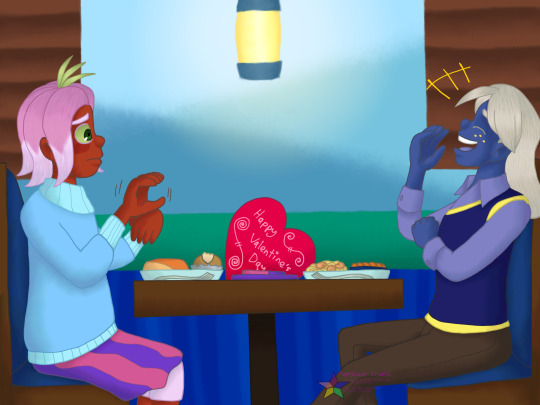
[Image Description: A digital illustration of Cosmos Stargazer (OP’s take on Smile For Me’s protagonist, the Flower Kid) and Theodore Shelley (one of OP’s Smile For Me OCs) sitting at a table at a seafood restaurant. Cosmos (left) is an androgynous young adult with reddish-brown skin, short pink and green hair, and green eyes with light green sclera. They are wearing a light blue sweater, a purple and pink striped skirt, and pale pink leggings. They have a concerned expression and are making the ASL sign for “chocolate”. Teddy (right) is a man with blue skin with gold freckles and shoulder-length beige hair. He is wearing a light blue button-up shirt, a blue sweater vest with yellow trim, and brown pants. He is laughing about the situation, holding one hand over his chest and the other near his mouth. On the table before them are a plate of salmon and baked potato, a plate of shrimp pasta and shrimp scampi, and a pinkish-red heart-shaped box with the text “Happy Valentine’s Day” in light pink lettering. The decor around them is mostly blue and teal with some lighter blue on the wall and brown blinds on the windows behind them. End ID.]
—–
Cosmos nodded, then they reached into the bag and pulled out their surprise: a bright red, heart-shaped box of chocolates, emblazoned with the phrase “Happy Valentine’s Day” in pastel pink script. L dropped his fork onto his place. Valentine’s? Valentine’s? He smiled in disbelief, and then he began to giggle a little, and before long he was unable to stop himself from full-on laughter. Cosmos put the box on the table in front of them and seemed a little dejected. “I thought you would really like chocolates,” they said. “You love sweets, it’s Valentine’s, it just fit…”
“N-nnnno, no, it, it’s…” L tried to calm himself, but it was taking a bit longer than he’d like, and his efforts to stifle his laughter to a more polite volume with his hands were making it impossible to sign instead. “Gi-give me, give me a s-sec-second…” Thankfully it didn’t take him too much longer to bring himself to a more reasonable level. “I legitimately forgot it was Valentine’s Day in all the classwork stress,” L said once he could sign again. “I thought somehow you knew my birthday, I spent all week trying to figure out how you knew!”
“It’s really your birthday?” Cosmos asked, stunned. “You’re a Valentine’s baby? Happy birthday! If I had known that, I would’ve gotten you a proper present!”
Aaaa more 101 Smiles and it’s laaate it’s almost my bedtime but that’s Fine, it’s a nice way to cap off my evening. Anyway, yeah, if you didn’t already know (or never caught it, it was a brief mention in Ursa Major) Teddy’s a Valentine’s baby! And yeah, this takes place before he picks his guy name, but since it stands for his middle name instead of his deadname I can see him still using L sometimes for like online aliases or whatever. I mean, it’s the mid-to-late-90s, people were still taking their internet safety seriously even as adults. Seriously, guys, take your internet safety seriously!! I only have my full name out there cuz I’m technically a published writer.
…and I just realized I forgot to draw in their drinks. Ummmm…the chocolates are leaning on them! Yeah, they’re just behind the chocolates…yeah…and Cosmos’s bag mentioned in the blurb is behind them… XD
💖🐶 Check out my pinned post for ways to support my artwork, among other things! 🐶💖
~If you like, please reblog to show your friends! Likes are appreciated, but reblogs let more people see my content! If you have something to say, feel free to give feedback in tags/comments/replies as well!~
Smile For Me and related concepts © LimboLane Cosmos Stargazer, Theodore Shelley, and artwork © PuppyLuver Studios
#smile for me#smile for me game#101 smiles#flower kid#cosmos stargazer#smile for me oc#theodore shelley#jess drew the thing#sfw#image description
10 notes
·
View notes
Text
Artist Books
Pre - 2000
1. "Songs of Innocence and of Experience" by William Blake
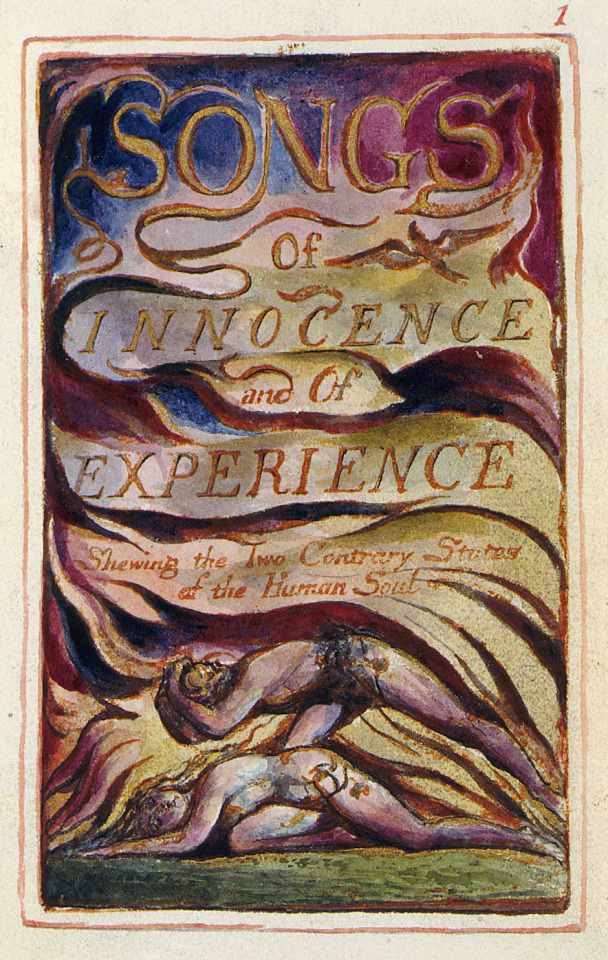
Songs of Innocence and of Experience is an illustrated collection of poems by William Blake. It appeared in two phases. A few first copies were printed and illuminated by William Blake himself in 1789; five years later he bound these poems with a set of new poems in a volume titled Songs of Innocence and of Experience Shewing the Two Contrary States of the Human Soul.
"Innocence" and "Experience" are definitions of consciousness that rethink Milton's existential-mythic states of "Paradise" and "Fall". Often, interpretations of this collection centre around a mythical dualism, where "Innocence" represents the "unfallen world" and "Experience" represents the "fallen world".Blake categorizes our modes of perception that tend to coordinate with a chronology that would become standard in Romanticism: childhood is a state of protected innocence rather than original sin, but not immune to the fallen world and its institutions. This world sometimes impinges on childhood itself, and in any event becomes known through "experience", a state of being marked by the loss of childhood vitality, by fear and inhibition, by social and political corruption, and by the manifold oppression of Church, State, and the ruling classes. The volume's "Contrary States" are sometimes signalled by patently repeated or contrasted titles: in Innocence, Infant Joy, in Experience, Infant Sorrow; in Innocence, The Lamb, in Experience, The Fly and The Tyger. The stark simplicity of poems such as The Chimney Sweeper and The Little Black Boy display Blake's acute sensibility to the realities of poverty and exploitation that accompanied the "Dark Satanic Mills" of the Industrial Revolution.
William Blake (28 November 1757 - 12 August 1827)
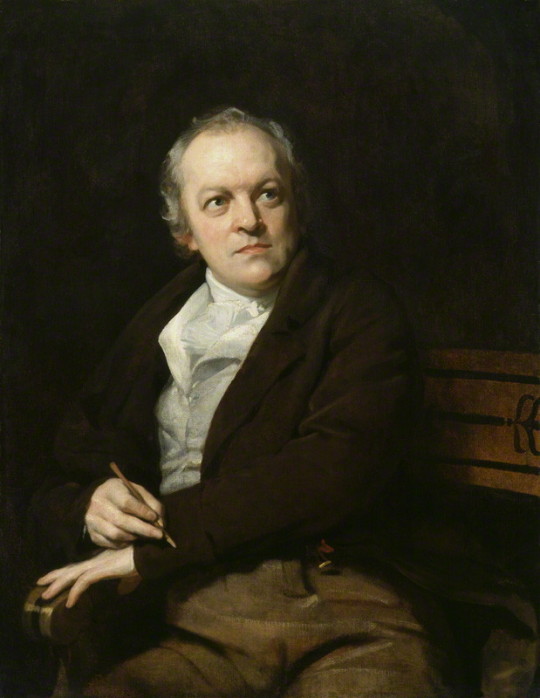
Poet, painter, engraver, and visionary William Blake worked to bring about a change both in the social order and in the minds of men. Though in his lifetime his work was largely neglected or dismissed, he is now considered one of the leading lights of English poetry, and his work has only grown in popularity. In his Life of William Blake (1863) Alexander Gilchrist warned his readers that Blake “neither wrote nor drew for the many, hardly for work’y-day men at all, rather for children and angels; himself ‘a divine child,’ whose playthings were sun, moon, and stars, the heavens and the earth.” Yet Blake himself believed that his writings were of national importance and that they could be understood by a majority of his peers. Far from being an isolated mystic, Blake lived and worked in the teeming metropolis of London at a time of great social and political change that profoundly influenced his writing. In addition to being considered one of the most visionary of English poets and one of the great progenitors of English Romanticism, his visual artwork is highly regarded around the world.
Because Blake's later poetry contains a private mythology with complex symbolism, his late work has been less published than his earlier more accessible work. The Vintage anthology of Blake edited by Patti Smith focuses heavily on the earlier work, as do many critical studies such as William Blake by D. G. Gillham.
The earlier work is primarily rebellious in character and can be seen as a protest against dogmatic religion especially notable in The Marriage of Heaven and Hell, in which the figure represented by the "Devil" is virtually a hero rebelling against an imposter authoritarian deity. In later works, such as Milton and Jerusalem, Blake carves a distinctive vision of a humanity redeemed by self-sacrifice and forgiveness, while retaining his earlier negative attitude towards what he felt was the rigid and morbid authoritarianism of traditional religion. Not all readers of Blake agree upon how much continuity exists between Blake's earlier and later works.
Psychoanalyst June Singer has written that Blake's late work displayed a development of the ideas first introduced in his earlier works, namely, the humanitarian goal of achieving personal wholeness of body and spirit. The final section of the expanded edition of her Blake study The Unholy Bible suggests the later works are the "Bible of Hell" promised in The Marriage of Heaven and Hell. Regarding Blake's final poem, Jerusalem, she writes: "The promise of the divine in man, made in The Marriage of Heaven and Hell, is at last fulfilled."
John Middleton Murry notes discontinuity between Marriage and the late works, in that while the early Blake focused on a "sheer negative opposition between Energy and Reason", the later Blake emphasised the notions of self-sacrifice and forgiveness as the road to interior wholeness. This renunciation of the sharper dualism of Marriage of Heaven and Hell is evidenced in particular by the humanisation of the character of Urizen in the later works. Murry characterises the later Blake as having found "mutual understanding" and "mutual forgiveness".
Other Works:
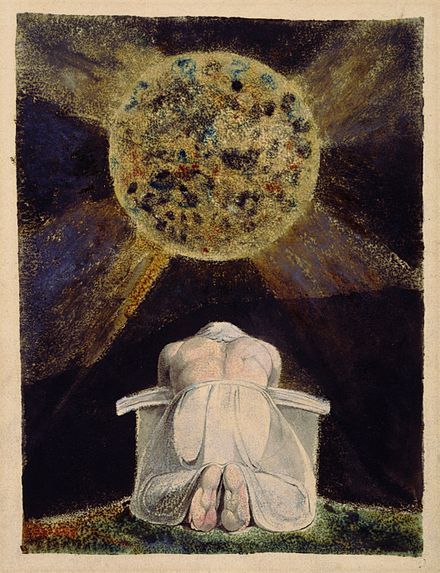
1. The archetype of the Creator is a familiar image in Blake's work. Here, the demiurgic figure Urizen prays before the world he has forged. The Song of Los is the third in a series of illuminated books painted by Blake and his wife, collectively known as the Continental Prophecies.
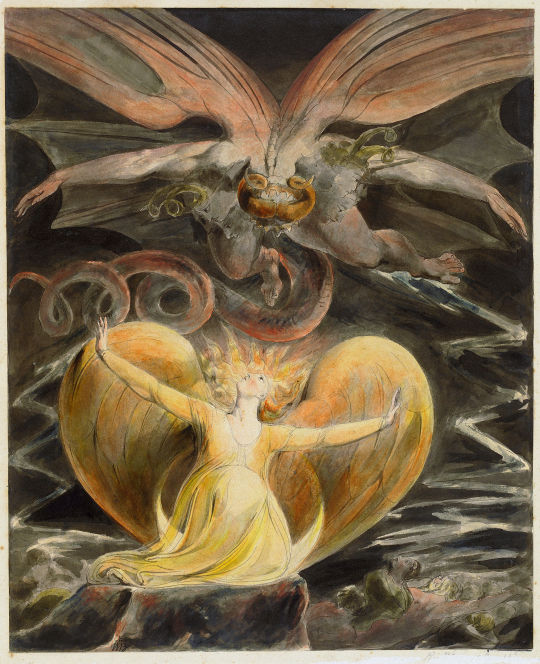
2. Blake's The Great Red Dragon and the Woman Clothed with Sun (1805) is one of a series of illustrations of Revelation 12.
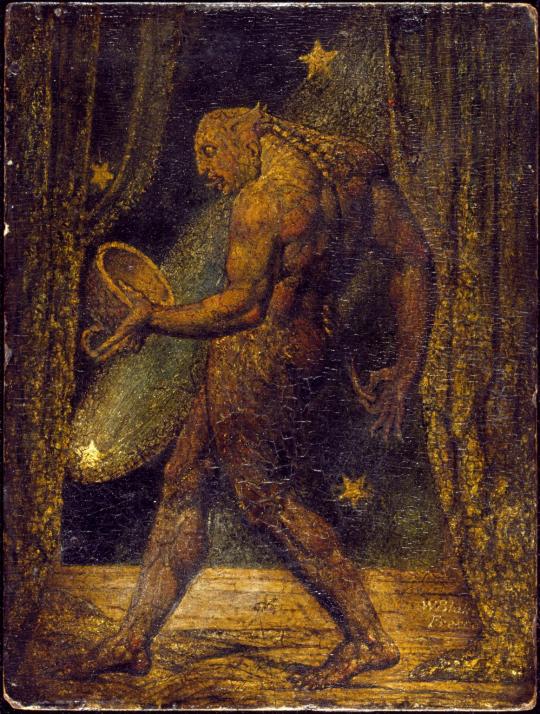
3. The Ghost of a Flea, 1819–1820. Having informed painter-astrologer John Varley of his visions of apparitions, Blake was subsequently persuaded to paint one of them. Varley's anecdote of Blake and his vision of the flea's ghost became well-known.
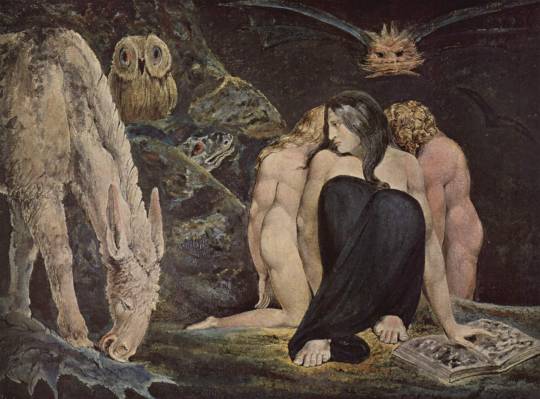
4. The Night of Enitharmon's Joy, 1795; Blake's vision of Hecate, Greek goddess of black magic and the underworld.
2. "Investigations—The Four Elements: Earth" by Daniel E. Kelm and Timothy C. Ely
The series of unique books Investigations: The Four Elements draws upon Kelm’s and collaborator Tim Ely’s shared interest in alchemy and sacred geometry. Each book consists of a set number of interlocking panels that can be assembled into one or more shapes forming Platonic solids.
The Platonic solids—tetrahedron, cube, octahedron, dodecahedron, and icosahedron—are polyhedrons with congruent sides, edges, and angles. Although these five shapes were known prior to Plato, they are specifically mentioned in his dialogue Timaeus. In this work, Plato describes these solids as the building blocks of matter, equating the tetrahedron with the element of fire, the cube with earth, the octahedron with air, the icosahedron with water, and the dodecahedron with the materials that form the stars and the cosmos.
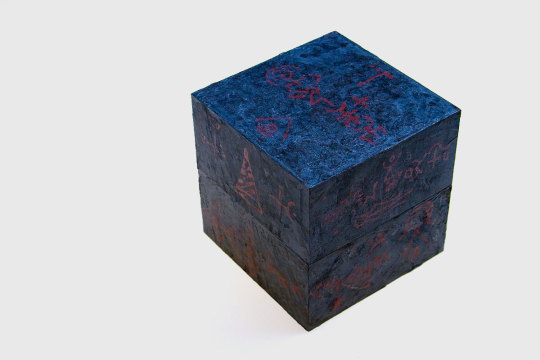
The closed box.
Book sculpture by Kelm.
Painting and surface treatments by Ely.
Acrylic and ink on paper, with airbrush acrylics, aluminium, brass tubing and rod, thread, and wire edge binding.
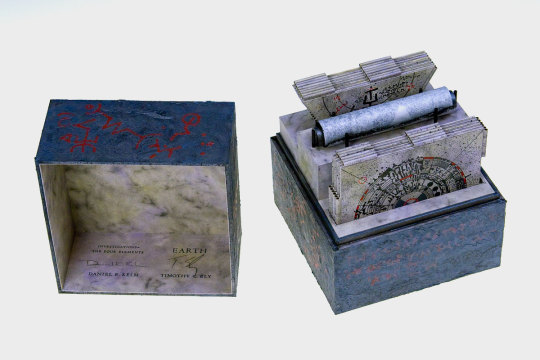
A first glimpse inside the box reveals shaped page panels and a metal tube with paper wrapped around it.
One slot in the box holds the square page panels and a second slot holds the triangular page panels.
The Investigations series is the earliest example of Kelm bindings with no permanent hinging; i.e., the pins can be removed and the pages completely disassembled.
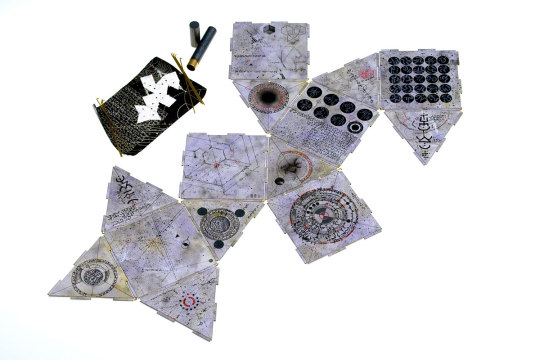
The metal tube contains the pins that will be used to hold the binding together.
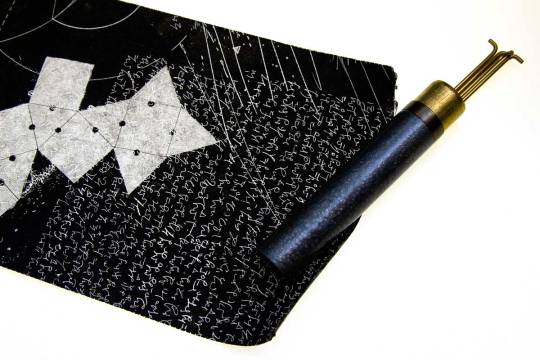
The paper scroll depicts a possible configuration of pages.
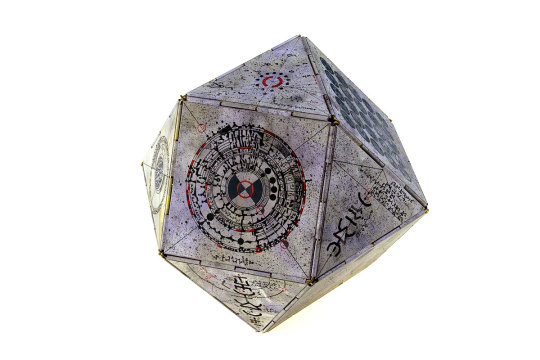
Here you see all the pages combined to form a cube-octahedron—which means that it is an integration of a cube and an octahedron.
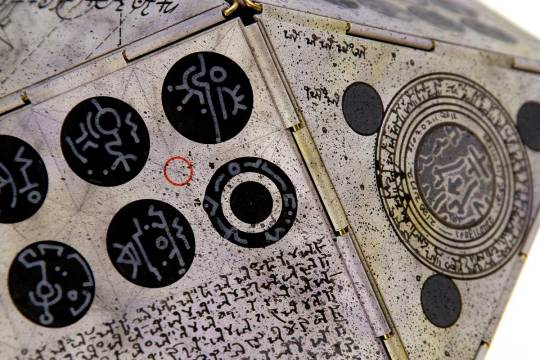
Detail of the painting and hinging.
Daniel Kelm
Daniel Kelm is a book artist, sculptor, book binder, and teacher. His intricate, detailed works invite unconventional ways of reading—which can resemble unearthing a mystifying treasure or solving a 3-D puzzle—and they condense wondrous topics that have laid between book covers for centuries—like alchemy, mathematics, science, metaphysics, maps, and illustrations—within visually astonishing bindings.
He invented the widely-used “wire-edge binding” and is the founder and proprietor of Wide Awake Garage studio in Easthampton, Massachusetts, where he designs and produces artist’s books and innovative sculptural bindings. His work has been shown nationally for over thirty years, and he has taught and lectured at universities and libraries in the U.S. and Europe.
Interview:
Lyra Kilston: Your work expands the form of what most people think of as a book: your works don’t need words, or images, or to open in an arc. In your view, what is the outer limit of having something remain a ‘book’?
Daniel Kelm: Books are a wonderful vehicle for telling stories. Most often the book artist constructs the book around their or an author’s story. Many of my books contain no recognizable words but are made of shapes that allow wide-ranging flexibility and movement. They are actually quite toy like, and if successful engage the “reader” in the same physical and interactive way as do toys. During that play, these wordless books can inspire someone to discover their own voice and story. I love watching someone interact with one of my sculptural books, then suddenly stop to tell one of their own stories.
What are some of your favourite materials to work with?
I love working with vegetable-tanned goat skin, a material commonly used in traditional fine bookbinding. For non-traditional work I tend towards metal, glass, and plastic. I’ve not found any material to be too rare or impossible to find and work with; there is always a way to invite it to play. In all cases, whatever the material used, it is important to discover its voice and to let that voice support the story being told.
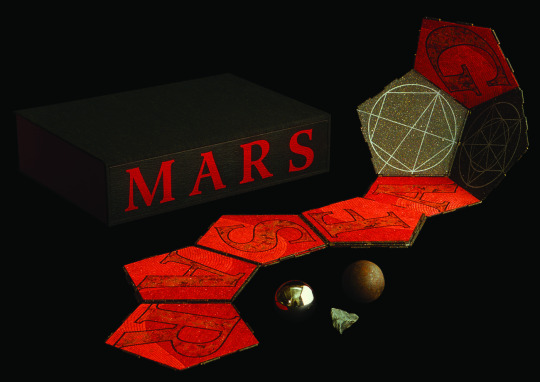
Mars, 1991–2005, Daniel Kelm. 11.5 x 8 x 3 in. (closed). Contents: box, accordion book partially pinned together, and three objects representing various aspects of Mars. Materials: paper board, paper, acrylic paint, thread, stainless steel wire, dry-mount adhesive, iron nickel meteorite, chrome steel ball bearing, Civil War iron canister ball, felt, fibre board, cloth. Techniques: wire edge binding, painting, photocopy transfer, airbrush, paste paper, silk screen printing, letterpress printing. Voice of Mars text by Taz Sibley. Letterpress printing by Art Larson.
What themes have you been working with recently?
After 20 years immersed in chemistry, I began a thirty-year study of alchemical processes that has inspired many of my artist’s books and sculpture. Experimentation with plant alchemy (spagyric alchemy) led me to an appreciation of pharmacy. In my latest work I’m exploring chemical and pharmaceutical processes through installations combining laboratory apparatus with antiquarian books describing the process.
I look at the installations as functional sculpture. The animating voice of each piece is that of the chemist, pharmacist, researcher, or lab worker who developed and explained the particular approach, so their name is usually intimately associated with it.
What is your research process like?
I often start with a description of a process or an image of the associated apparatus and then find out everything that I can about it, including details about the life of the person who developed it. My work always tries to integrate the personal connection (through the life of the individual associated with the science involved), the historical (by choosing a process that has been proven through its historical record to be significant to our lives), the aesthetic (as seen in its sculptural quality), and the technical (the details of the process and materials themselves).
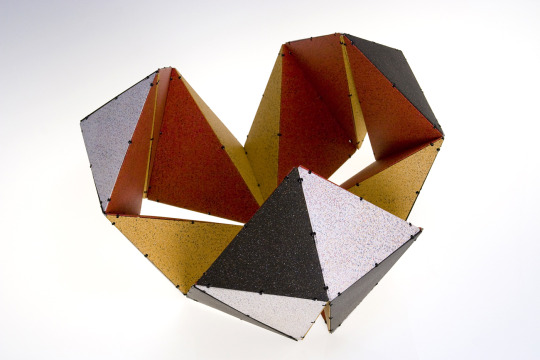
Relgio Mathmatica, 1990–2007, Daniel Kelm. 9 x 9.5 x 9.5 in. Materials: paper and paper board, stainless steel wire, thread, English yew wood, paint, leather. Techniques: wire edge binding, spattering, paste paper. Photographer: Jeff Derose, One Match Films. Binding assistance by Kylin Lee. This video of Kelm manipulating the binding shows how the “Lotus Flower” configuration closes—the red cube moves to the inside, and the black and white surfaces to the outside.
Sources used:
https://en.wikipedia.org/wiki/Songs_of_Innocence_and_of_Experience
https://en.wikipedia.org/wiki/William_Blake#Development_of_his_views
https://www.poetryfoundation.org/poets/william-blake
http://www.danielkelm.com/core/wideawake/3/1#/galleries/2
http://www.danielkelm.com/core/wideawake/3#/entry/wide-awake-garage-videos
https://blogs.getty.edu/iris/alchemical-book-artists-at-work-part-2-daniel-kelm/
Post - 2000 Artist Books
1. "Don't Lose Heart" by Anne Gilman
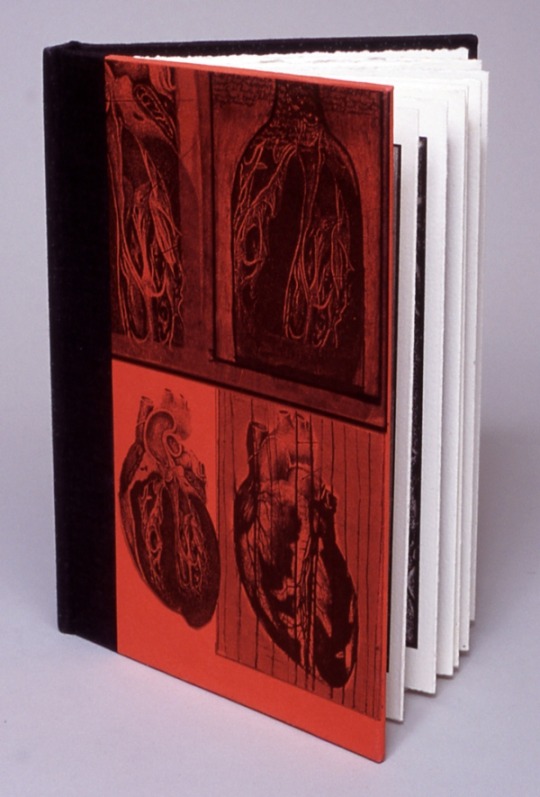
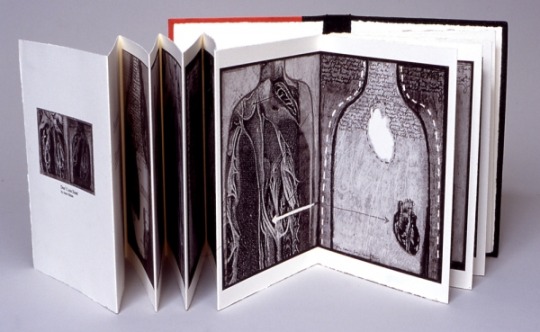
Don't Lose Heart 2001 mixed media digital accordion book printed on Arches cover stock, edition of 10 9" x 6" x 1" Don’t Lose Heart contains a play on expressions we use with the word "heart". Below is the text that appears at the end of the book:
You can have a change of heart, a heart of gold, a heavy heart, a heart to heart.
You can eat one’s heart out, lose heart, have a heart, take heart.
In my heart of hearts, with a heavy heart, cross my heart, from the bottom of my heart, Don’t lose heart.
Anne Gilman

Anne Gilman is a Brooklyn-born artist who works in varying formats that include large-scale drawings and multi-panel projects. The political, social and personal concerns that fuel all forms of moods, worries, and psychological states of being are the materials that feed her work. She begins by using her own thoughts and experiences as a starting point for considering larger issues of why we do what we do, what matters and how we can get lost in distractions that are ultimately unimportant. The resulting drawings are a mapping of information, thought and emotion.
Other Works:
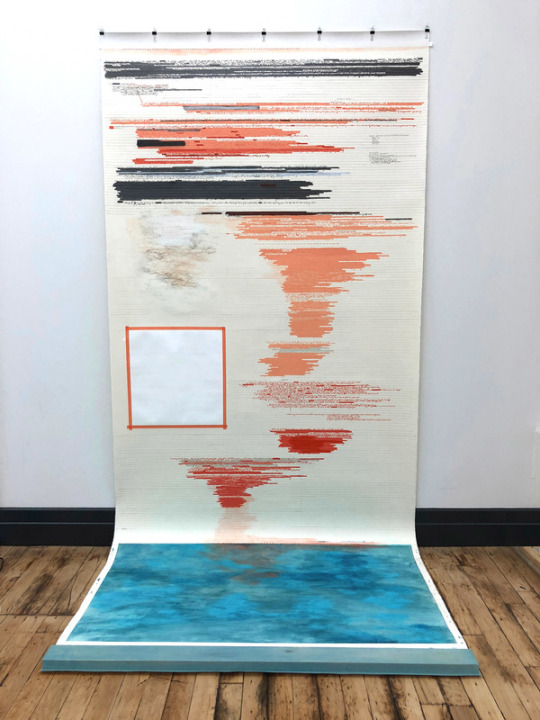
Sundowning 2018 pencil, graphite, paint, tape, ink, on paper with hand-stained wood 134 x 60 inches
Sundowning (also known as a sundown syndrome) = a neurological phenomenon associated with increased confusion and restlessness in patients with dementia. It occurs in the late afternoon/early evening. Symptoms include increased agitation; a person may become more upset/anxious/confused/disoriented/suspicious
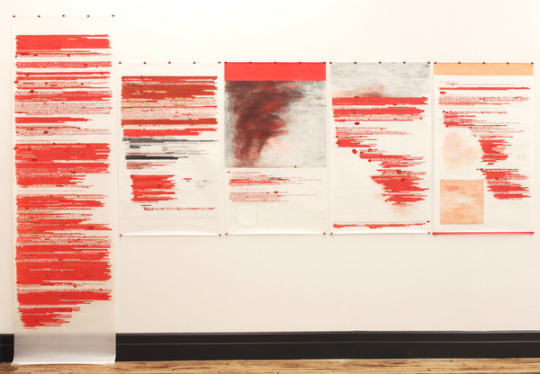
Boiling point (5 works in this series) 2018 ink, pencil, tape on mulberry paper One section is 94½ x 27½ inches and the other four are 46 x 27½ inches
“A part of the writing in these drawings focus on issues of anger and rage. I was thinking about the levels of discontent that people live with, whether triggered by relatively insignificant incidents or by a build-up of frustration over time, and the need for an appropriate outlet to diffuse and address the intensity, before it erupts in explosive ways.” A. Gilman
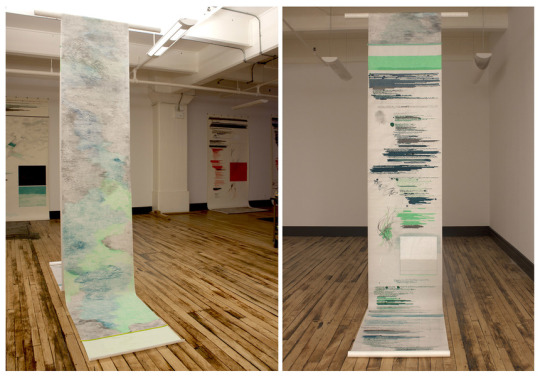
this place / this hour 2019 Coloured pencil, graphite, ink, and washi tape on mulberry paper 321 x 27 inches
“I was invited to do a project commemorating the 200th anniversary of Walt Whitman’s birth. My research resulted in this two-sided 27-foot scroll and a limited-edition artist book. In both projects Walt Whitman’s words, process and internal struggles are intertwined with my own. This scroll is suspended from the ceiling and extends across the floor in two directions. This view shows the non-text side of the scroll on the left side and the text-based side of the scroll on the right side.” A. Gilman
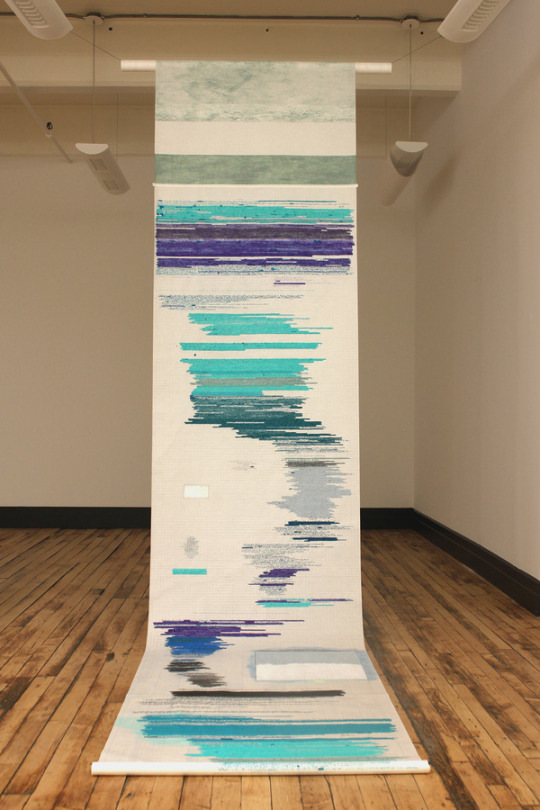
Up close / in the distance / now 2018 pencil, graphite, tape, ink, BIC ballpoint pen, matte medium on mulberry paper 340 x 38 inches
This scroll suspends from the ceiling with one side showing primarily the text part of the work and the other side showing non-text drawing. This view shows the text side. The next two images show other views.

Up close / in the distance / now 2018 pencil, graphite, tape, ink, BIC ballpoint pen, matte medium on mulberry paper 340 x 38 inches
This view shows the scroll from the side. The next view shows the non-text side of the drawing.
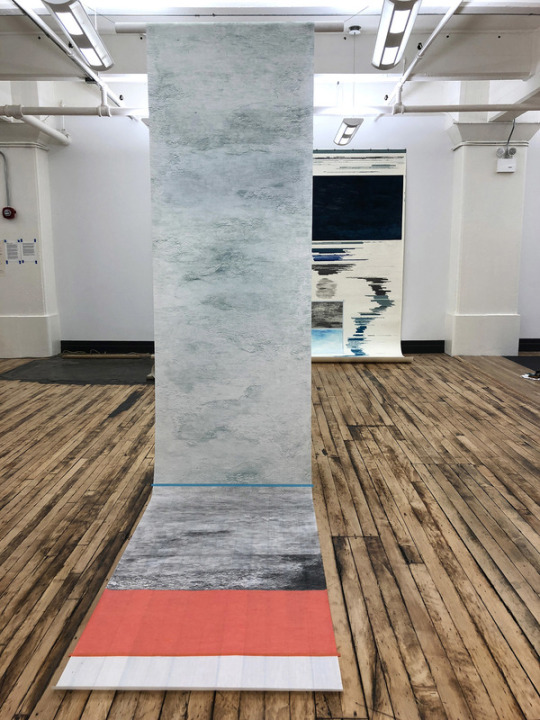
Up close / in the distance / now 2018 pencil, graphite, tape, ink, BIC ballpoint pen, matte medium on mulberry paper 340 x 38 inches
This is a view of the non-text side of the drawing.
2. “Second Road” by Timothy C. Ely
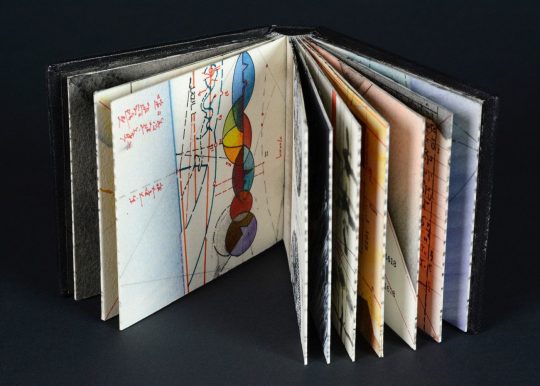
Second Road, 2016, Timothy C. Ely. Drum leaf binding, full leather, watercolor, dry pigments, gold and ink on paper. All images in this post courtesy of the artist.
Timothy C. Ely
Ely studied design and printmaking and has been making books for over forty years. (He also owns sixty books on baking bread, his other passion that relies on precision and a bit of alchemical magic.) He has shown his work at museums around the country and it is in many private and public collections.
Interview:
Lyra Kilston: Do you have a favorite rare or ancient book? Have you been able to see it in person?
Timothy Ely: The Gutenberg forty-two-line Bible, which I saw in New York’s public library. I have handled this book, and revel in the idea that it is a point on the historical timeline where we switched over from the book as a handmade ideal to an industrial product. My work is embedded in the ideas of pre-Gutenberg technology, with as much of the production being done by hand and the content generated by long contemplation and the intuitive handling of method.
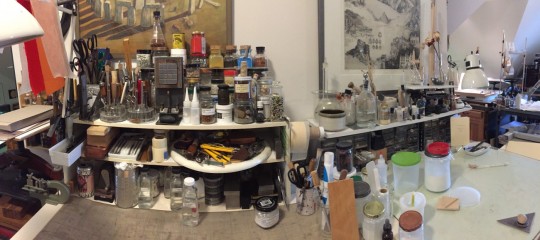
Timothy C. Ely’s studio, 2016.
You work with fascinating materials, like animal skin bindings and nineteenth-century paints. What are a couple of your favorite materials to work with? Is there a material that you’d love to work with, but it’s too rare or obsolete?
I envision making a large vellum book using a contemporary variant on an old technology. I have a vellum model in the works which has been in the press for sixteen years. Vellum is expensive and requires much animal husbandry to provide foliation for the artist. This book-to-be needs patronage.
Other favorites are rare pigments made of materials from obscure locations. Not so much for what they materially do but what associations are formed. Meteoric dust (I have some from a meteor that fell around the time of Columbus), sand from Asian deserts, soil from the gardens of bookbinders and monasteries. My collection is vast and my spies numerous. This material adds form to covers but on occasion finds its way into the interior.
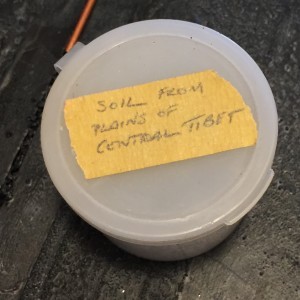
Soil from the plains of Central Tibet, one of many unique materials in Ely’s studio.
Your work takes inspiration from a range of sources, from ancient runes to science fiction to the spiral pattern on a pine cone. What themes have you been working with recently?
I am attempting to render the invisible, to describe some ideas like 4-D architectural renderings and diagrams of the ineffable. By using well-tested ideas such as symbolic visual descriptions, I can make an foray into how we might imagine the path of a particle or a hunch.
What is your research process like?
My process is to draw, fail, evaluate, draw again, erase, redraw, abandon hope, find the path again, read something, draw more, melt something or hammer it together, fuse things, make some bread, draw again, and continue to see what shows up. Often up, sometimes down—it is never a linear process, but one that works by continuing to work with purpose against a plane which cannot easily be scaled.
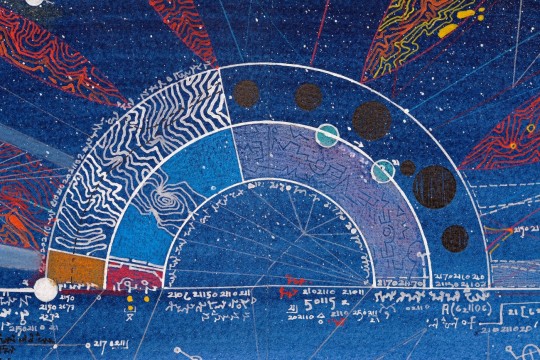
The Observatory, 2006, Timothy C. Ely. Ink, gouache, and dry pigment on paper.
Sources used:
https://www.annegilman.com/
https://www.annegilman.com/artist-books/limited-edition-artist-books/view/57
https://www.annegilman.com/artist-books/limited-edition-artist-books/view/58
https://www.annegilman.com/scroll-drawings/scrolls-on-and-off-the-wall/1
https://www.annegilman.com/scroll-drawings/scrolls-on-and-off-the-wall/2
https://www.annegilman.com/scroll-drawings/scrolls-on-and-off-the-wall/6
https://www.annegilman.com/scroll-drawings/scrolls-on-and-off-the-wall/3
https://www.annegilman.com/scroll-drawings/scrolls-on-and-off-the-wall/4
https://www.annegilman.com/scroll-drawings/scrolls-on-and-off-the-wall/5
https://blogs.getty.edu/iris/alchemical-book-artists-at-work-part-1-timothy-c-ely/
3 notes
·
View notes
Text
Kami: Spirits of Shinto (Gods Collection)
Kami are believed to be “hidden” from this world, inhabiting a parallel existence that mirrors our own, known as Shinkai (the world of the Kami). Followers of Shinto believe that to be in harmony with the greatness of nature is to be conscious of ‘kannagara no michi’ (the way of the Kami).

Westerners associate Kami with spirits or gods, but followers of Shinto regard them differently. They are not divine like the transcendent and omnipotent deities found in many religions. Neither are they perfect, as they often make mistakes and behave badly. There are more like extensions of the natural world, unpredictable like the weather, sometimes warm like the sun, or as hard and cold as ice. One of the first Kami in existence was Amatsu-Mikaboshi (August Star of Heaven). He was the lord of the middle heavens, associated with the Pole Star, and early myths describe him as a manifestation of chaos. Eventually this chaos was shattered into two parts, known as Yo and In (male and female energy). Mikaboshi’s primordial chaos then became a background force that is said to create all the disorder in the world (e.g. human passion, earthquakes, and social anarchy). One of the first gods to emerge from the newly formed cosmos was Izanagi. Together, with his sister Izanami, they created the islands of Japan, and sired the first lineage of Kami. Sadly, Izanami died after giving birth to the fire-god Kagu-tsuchi. Izanagi tried to rescue her spirit from the Underworld, but when he saw her monstrous form, he abandoned his attempt. To avenge her shame, she promised to kill a thousand of humans every day. Izanagi responded by saying her would then create one thousand, five hundred lives to ensure the survival of humanity. After his descent into the Underworld, Izanagi began to wash his face from the pollutants of the nether lands. As he washed in a pool, three deities emerged from his face: Susanoo, the sea Kami, was born from his nose; Amaterasu, the Sun Kami, was born from Izanagi's left eye; and Tsukuyomi, the moon Kami, was born from his right eye. Tsukuyomi lived in the heaven with his sister Amaterasu, who later became his wife. Tsukuyomi angered Amaterasu when he killed her friend, Uke Mochi, the goddess of food. After she learned of his foul deed, she refused to ever look at Tsukuyomi again, forever moving to another part of the sky. Susanoo, is known as the Kami of sea storms, whose powerful gales come into force during the summer months. There was a long-standing rivalry between Susanoo and his sister Amaterasu, which came to a head when Susanoo destroyed his sister's rice fields and killed one of her attendants. Amaterasu was so angry, that she took to hiding in a cave, drawing the world into perpetual darkness. It was Omoikane, the Kami of wisdom, who helped return the world to light once again. His name means "serving one's thoughts," and his followers often call upon him for insight and good counsel. He was able to hold many thoughts at once or combine them to form one profound insight. At the time Amaterasu hid away in the rock cave of Heaven, Omoikane considered various measures to draw her out again, which led to the successful return of Amaterasu to the world. Whereas Susanoo was the Kami of the sea storms, Ryūjin was the Kami of sea itself. He was often depicted as a dragon, symbolising the power of the ocean, and was able to take on human form. He lived in a palace under the sea, built out of red and white coral. Ryūjin was the father of the Kami Otohime, who married the hunter Hoori. Their grandson would become the first leader of Japan, (‘Emperor Jimmu’). This means that the Imperial dynasty of Japan is descended from the great sea Kami, Ryūjin. Another famous water deity was Suijin, the Kami of fresh water. He is the guardian of the fishing folk, fertility, and child-birth. People revere Suijin, hoping for clean drinking water, strong crop yields, and for successful fishing trips. Shrines devoted to Suijin can be found throughout Japan at springs, streams, rivers etc. They are marked by stone markers devoted to the Water Kami, and are considered extremely sacred. Raijin was a storm Kami, who drew upon the waters of Suijin to produce rain, thunder and lightening. He is typically depicted as a demon-looking spirit beating drums to create thunder. Raijin was created by the divine pair Izanami and Izanagi after the creation of Japan. Raijin's companion is the demon Fūjin - the Kami of the wind and one of the eldest Shinto gods. He is portrayed as a terrifying wizard-like demon, resembling a green-skinned humanoid wearing a leopard skin, carrying a large bag of winds on his shoulders. At the moment of his birth, it was said that his breath was so powerful that all the clouds and mists in the world were immediately dispersed and world was full of brightness. Another powerful deity who grew to prominence in Japan was Hachiman, the Kami of war. In his earliest incarnation, Hachiman was a Kami of abundance who was prayed too for a good harvest. Later he was associated with the legendary Emperor Ōjin (3rd - 4th century CE), who was deified as a guardian of Japan. As a Kami of prosperity and martial prowess, Hachiman then became an ideal Kami for the Samurai to follow. Throughout the Japanese medieval period, the worship of Hachiman spread throughout the country, revered by both the peasantry and the samurai. To help temper the aggressive pursuits of warlords, many Japanese people worshipped Ninigi, the Kami of politics. He was the grandson of Amaterasu, sent to earth to pacify the Japanese. He gifted them three celestial artefacts; the sword Kusanagi, the mirror Yata no kagami, and the jewel Yasakani no magatama. Whoever held these gifts were said to be the true descendants of Amaterasu herself. Later, Ninigi married the daughter of an earth kami, called Ōyamatsumi. Together, they sired the first emperor of Japan, Jinmu. Not all Kami emerged during the formation of Japan. Tenjin was the Kami of scholarship, who was the deification of the legendary scholar Sugawara no Michizane. He was a politician who rose to great heights in the late 9th century. At the beginning of the 10th century he fell victim to a plot by a rival family (the Fujiwara), who had him exiled. After his death in 903 CE, the city was struck by a powerful storm, and many of the Fujiwara clan died. The court came to the conclusion that the storm was caused by Michizane's angry spirit. In order to placate it, the emperor restored all Michizane's offices, burned the official order of exile, and ordered that the poet be worshipped under the name Tenjin, which means sky deity. ARTWORK BY Christophe Bastin Leonardo Borazio Rodrigue Pralier Milek Jakubiee Dariyen Darian Read KAMI: SPIRITS OF SHINTO (GODESSES COLLECTION) here: http://bit.ly/2DQLWEk If you’re looking for a really immersive experience of world mythology, why not subscribe to my Patreon page, and gain: Access to in-depth posts on the gods, monsters & heroes of world myth Entry to my FB group on the 'Tales of the Monomyth,' AKA the first story ever told A 'behind the scenes' peek at my upcoming novels & much much more! www.patreon.com/HumanOdyssey
#kami#shinto#shinkai#amatsu-mikaboshi#izanagi#tsukuyomi#susanoo#omoikane#suijin#ryūjin#Raijin#Fūjin#hachiman#ninigi#tenjin#japan#japanese
8 notes
·
View notes
Text
I’m reading more about overcoming anxiety and insecurity on my own, as what my psychologist presents me with about about mindfulness and meditation definitely has stirred things up rather than calmed them down. But to give her approach some credit - this has allowed me to analyze what it is I might need to consider.
First I ought to establish who I am. When someone asks about me or how I’ve been, I quickly jump to talking about my artwork and my relationships. Both are extremely important to me and sources of great joy, but also great anxiety.
I couple my own self-worth with the quantity and quality of art I produce in a given week, and still feel crushing guilt or frustration when I pursue too many activities that don’t have a tangible creative output, tasks such as cleaning (I’ve been trying to “Marie Kondo” my home) and playing games. I’m definitely better on this score than I used to be, but still have a long way to go in genuinely convincing myself that it’s not only important and okay not to create all the time, but extremely necessary and healthy not to.
I put a ton of thought, feeling, and energy into my relationships, most especially romantic relationships; this has always been the case. That might sound positive but historically it’s always caused trouble, as I approach loving others with an amount of passion that registers as obsessive. I’ve gotten much better in this realm than past me was, and figuring out polyamory was a huge part of that, but I still crave a lot of contact with my partners and frequently think of myself in relation to them. I love my husband and I love my girlfriend, but I shouldn’t define myself by having them in my life, or feel fear when they’re not as present - we are separate and whole individuals that enjoy each other and help each other out, not people getting thrown together into a blender. Seeing them grow as people makes me want to pursue meaningful change for myself, too.
So my art and my partners are important aspects of my life - but who am I?
I’m an emotional creature that feels deeply for the universe around me. I emphasize with every living thing and try my best not to cause any hurt when it can be avoided, from people to even the tiny bugs that enter my home. I love the smell of coffee, the sparkle of fresh snow, and the ethereal glow of dust drifting through motes of sunlight. I believe humans are just another animal and the fabric of society is a wild act of mutual creativity - a collective tool of cooperation but not the end all be all of anything. The wonder of the cosmos itself is the closest I come to experiencing religious awe, and I find both science and art to be the most remarkable pursuits to separate us from our kin of other species, if anything. Storytelling, both absorbing those spun by others and weaving my own, fills me with a passion sometimes equivalent to what I feel for my friends and partners. I hope reincarnation or another form of continued life winds up being the reality of death, but if it is not I still believe living has meaning, and perhaps doubly so: to collect experiences, bring joy to others, and leave the world better than we entered it. When I meditate I see myself as a dark furred wolf with yellow eyes and a graying muzzle; in art I more commonly represent myself as an anthropomorphic lurcher with visual traits borrowed from both my actual physical self and the three greyhounds I grew up with. I’ve experienced phantom limbs and strange dreams that connect me to this form of self-expression more strongly than I’m attached to the flesh and bone me. Whether I’m some form of therian or just a dreamer who imprinted heavily on animals as a child is unclear to me. Along that same vein - I’m always trapped somewhere between skepticism and mysticism, refuse to settle on either at this point in my life, and I’m at peace with that. I’m nearly thirty years old and recognize that I have so much more to experience and learn, but that everything is uncertain and I could just as easily be dead tomorrow. The purr of a cat and the laughter of a friend are both sounds that mend my heart. I enjoy burning candles, playing short aggressive card games, cuddling, and best express myself through writing and drawing. I’m an extrovert in that I feel a boost from the energy and presence of others, and I love a number of people very intensely.
I guess by the end there I looped back around to my initial acknowledgements, but maybe from a slightly healthier perspective? Either way that was a refreshing stream-of-conscious thing to write. I’m not sure how to summarize or identify self succinctly, but I will work on it. ❤️
6 notes
·
View notes
Photo

PSPSPSPSPSP another WIP, guess what’s taken over my life~ // @sabredanse
#🜺 Cosmos can Draw Sometimes | ARTWORK#h-hewwo#sabredanse#i cant.... draw armor or fashion so guess what was the worst game to try and doodle#uhhhhhhhhh this one#ITS BASED ON THAT THING WE TALKED ABOUT#THAT /THING/ U KNOW#♡ PASSIONATE from miles away | BLOOMING even in blistering winters | Hades & J’isu | sabredanse
13 notes
·
View notes